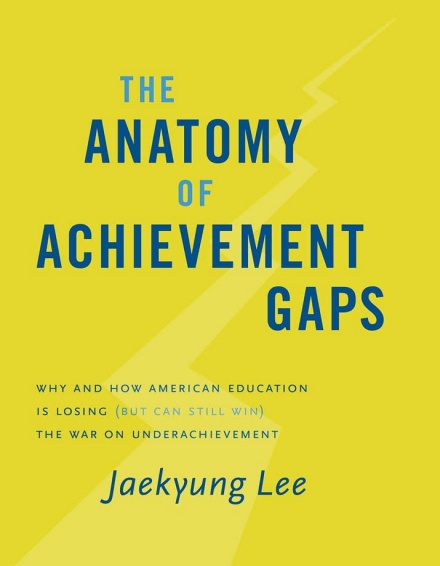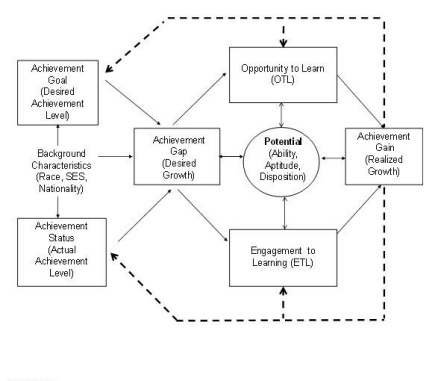The Anatomy of Achievement Gaps
Hello, I am Jaekyung Lee, professor of education and former dean here at the University at Buffalo, State University of New York. Thank you for visiting my project homepage.
This project started with the premise that public education is central to solving many national and global challenges and that scientific research should inform educational policy decisions. Rapid social changes induced by a knowledge-based economy, globalization, immigration and technological advances make many of the current school reform efforts outdated and ineffective to meet tomorrow’s societal needs.
The nation’s public education system is responsible for the full development of all children’s potential, and this serves to create effective and sustainable responses to global challenges for humanity in the digital age. There are growing concerns that the United States has veered away from its ideal as the land of opportunity, where public education is the engine of economic growth and social mobility.
Currently, the United States is at war and the nation’s future can be at risk. The war to which I refer is the war on student achievement gaps, a war that was waged decades ago and has proven extremely difficult to fight and complex to understand. Is American education system losing its war on achievement gaps? Can American schools and colleges still win the war on underachievement? Why and how? To answer those questions, I draw on a wide range of educational data sources and indicators across B-P-16 education pipeline (i.e., the full spectrum of birth through preschool and elementary school through college).
Lee, J. (2016). The Anatomy of Achievement Gaps: Why and How American Education is Losing (but can still Win) the War on Underachievement. New York: Oxford University Press.
Revealing that more than half of American students’ academic growth potential has been lost over the past several decades, this book reframes the war on achievement gaps as the ubiquitous challenge of discovering and realizing untapped potential for all students. The book extends the scope of analysis from the K-12 to the B-P-16 (from birth through college) education pipeline and from domestic racial/social group comparisons to international comparisons with a focus on South Korea. Through integrated analyses of national and international datasets, the book provides new evidence on the status and alterability of achievement gaps, the causes of these gaps, and the effects of educational policies on the gaps. Although underachievement prevails due to inadequate and inequitable learning environments in both homes and schools, the American education system has strengths and can still win the war on achievement gaps. The book presents a new vision and strategies for education reform to defeat statistical projections of the trend.
Here, I reframe the achievement gap issue to be about the underachievement of many students rather than just traditionally underperforming racial minorities and disadvantaged subgroups. Anyone in the U.S. or any country can be an underachiever, if there exists unrealized potential relative to achievement goals set at particular time points for individual persons, groups and organizations. The term “underachievement” has the connotation of unrealized potential (strength) as well as inadequate performance (deficit). Winning the war on achievement gaps requires fighting battles from comprehensive and balanced views, that is, reinforcing existing strengths as well as fixing deficiencies toward a strategic vision of the future state.
To guide educational policy and practice for tackling the achievement gap problems toward harmonious pursuit of both excellence and equity goals, I have developed a model of “Balanced Achievement Gap Management System” (BAGMS). Figure A below shows the layout of BAGMS model that visualizes the dynamic cycle of relationships among key component variables.
Figure A:
Model of Balanced Achievement Gap Management System
Achievement gaps arise from the discrepancy between desired goals/standards and current status. The goals can be set with reference to either standards or norms (or a combination of both) for the target population of students in an education system, while the goals may be adapted for accommodation of specific subgroup needs with reference to their learning potential and environment conditions. Background characteristics may not only influence the status of current achievement but also impose boundary for the future state of possible achievement. The goal may be set low within this boundary or high enough to push the boundary out further. The best capacity and efforts by which students come to realize their full potential determines the degree of deficits relative to goals. Under the situation of inadequate opportunities and/or efforts, the gap is treated as unrealized potential (underachievement) that can and should be closed through continuous improvement of the educational environment and practice. The BAGMS model focuses on two key conditions for academic growth: (1) engagement to learning (ETL) and (2) opportunity to learn (OTL).
Achievement gaps change over the course of child development and education. This requires dynamic views about the measurement and analysis of achievement gaps. Herein, achievement gaps are operationally defined as any measured difference between how children learn and grow (actual learning growth) and how children could learn and grow under ideal circumstances (desired learning growth). This new framework can help inform the design and evaluation of education policies for closing the achievement gap in ways that improve both academic excellence and equity. This perspective is an improvement from perspectives used in prior research where there was imbalance (and separation) of attention between the two parts of the achievement gap equation: how children actually grow, as described by empirical data (e.g., longitudinal studies of achievement trajectories), and how children should grow, as prescribed by social expectations/norms or policy goals (e.g., college and career readiness targets of the common core). With this new definition of “achievement gap”, this research brings these two key components, actual and desired trajectories, together.
The central methodological approaches in this book are multilevel and longitudinal analyses of large- scale datasets that provide multiple measures of educational inputs, processes, contexts, and outcomes. Prior research on academic growth trajectories has several limitations: (1) there is a disconnect between micro-level human development research and macro-level institutional and policy research, (2) there is a lack of generalizability due to limited time span and local data, and (3) there is a paucity of valid measurement and statistical methods (e.g., norm-referenced test measures limiting the validity of assessing growth). Our understanding of growth can be upgraded with advances of in the national longitudinal datasets that use developmental scales of reading and math achievement through P-12 education (e.g., item response theory models). Furthermore, the development of growth curve modeling (e.g., hierarchical linear models) also facilitates the multilevel analysis of child growth trajectories. Building on relevant theory and prior research, I have analyzed national datasets to address the nature and extent of the achievement gaps, the sources of achievement gaps, and the effects of schooling and educational policy interventions.
Takeaway #1 — Underachievement problem is serious and ubiquitous in American education
The evidence of unrealized potential is found in every corner of our education system: (1) the gap between IQ gain and achievement gain, (2) the gap between college aspirations and actual attainments, (3) the gap between school funding gain and student achievement gain, (4) the gap between predicted (based on social and educational environment changes) achievement gain and actual achievement gain, and (5) the gap between US and other nations, particularly lower-SES and higher-performing Asian countries. Approximately half or more of the nation’s academic growth potential based on available talent, resources, and capacity has been either lost or wasted. In other words, American students’ achievement could (and should) have improved at least two times more than it did over the past several decades.
Takeaway #2 — Racial achievement gaps are inequitable and heterogeneous
Many American students’ underachievement is largely a consequence of untapped potential; that is, inadequate and inequitable educational opportunities and efforts throughout the system. Traditionally, the underachievement problem tended to be most severe at the middle and high school levels and most prevalent among disadvantaged black and Hispanic groups. Now, achievement gap issues extend to preschool, elementary school, and college levels and also make white and Asian-American groups vulnerable. Even the highest performing racial minority group within the United States—Asian-American students—are experiencing the problem of being the “big frog in a small pond” because they manage to maintain only a slight edge over other groups within their own country yet substantially lag behind native Asian students with the same ethnic backgrounds outside the United States. Switching the reference group for interracial comparison from white to Asian students would not only enlarge the size of relative achievement gaps for blacks and Hispanics, but also weaken the relative importance of family socioeconomic status (SES) as an explanatory factor of underachievement; their gaps in academic engagement as well as school learning opportunities become more salient.
Takeaway #3 — Neither (school) funding nor testing works for closing the achievement gaps
The foundation for racial equity was built in the 1960s and ‘70s, when education and social policies worked to narrow the achievement gap by guaranteeing a minimally adequate level of achievement for minorities through compensatory education, minimum competency testing, school desegregation, equalization of school funding, the War on Poverty, and affirmative action. However, the past policies had limitations since the progress was restricted to basic skills among blacks. Standards-based education reform and test-driven accountability movement since the 1980s did not fulfill the promise of upgrading skills for all students. The average effect of (costly) input-driven interventions such as class size reduction and teacher quality improvement was modest, although their effects tend to be relatively larger for disadvantaged, low-achieving and younger students. The average effect of (relatively cheaper) high-stakes testing interventions was modest; the No Child Left Behind Act (NCLB) policy failed to narrow achievement gaps. A proper mix of input-driven and performance-driven educational interventions (i.e., combination of capacity-building and incentives) may help improve cost-effectiveness (bang for the buck) for both excellence and equity goals. At the end of the day, schools alone cannot close the achievement gaps.
Takeaway #4 — B-P-16 education pledge can be a game changer for American education system
Winning the war on achievement gaps will require a paradigm shift, one with broad-based visions and long-term policy strategies for education formed in a knowledge-based society over the next 100 years. Based on national trends, the projected time needed for closing the current achievement gap looks dismal. For example, it may take up to 100 years to close the black–white gap or it may not even happen to close the Korea–US gap. However, under the scenario of implementing universal B-P-16 education (from birth-preschool through college) with new policy strategies, the nation may plan to close the black–white achievement gap in 30-plus years and the Korea–US achievement gap in 50-plus years. A vision of “B-P-16 education pledge” is proposed as the organizing principle of American public education system. In spite of the achievement gaps, American education has unique strengths so that education reform needs a balancing act, fixing the weaknesses of schools without ignoring and undermining existing strengths such as diversity, creativity and innovation (conversely the weakness of Asian education model).
Achievement Gap Effect Size Calculators
Data and Indicators
Interventions and Research Methods
Watch my research seminar at the University of Canberra
Dr. Jaekyung Lee — Invited Talk on Educational Inequalities and Achievement Gaps
Aug. 22, 2018

